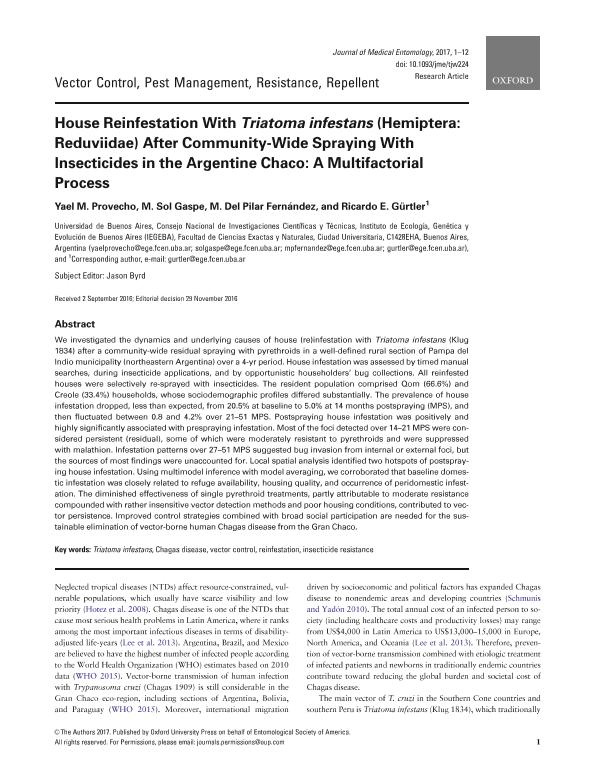Artículo
House Reinfestation With Triatoma infestans (Hemiptera: Reduviidae) After Community-Wide Spraying With Insecticides in the Argentine Chaco: A Multifactorial Process
Fecha de publicación:
05/2017
Editorial:
Oxford University Press
Revista:
Journal of Medical Entomology
ISSN:
0022-2585
Idioma:
Inglés
Tipo de recurso:
Artículo publicado
Clasificación temática:
Resumen
We investigated the dynamics and underlying causes of house (re)infestation with Triatoma infestans (Klug 1834) after a community-wide residual spraying with pyrethroids in a well-defined rural section of Pampa del Indio municipality (northeastern Argentina) over a 4-yr period. House infestation was assessed by timed manual searches, during insecticide applications, and by opportunistic householders' bug collections. All reinfested houses were selectively re-sprayed with insecticides. The resident population comprised Qom (66.6%) and Creole (33.4%) households, whose sociodemographic profiles differed substantially. The prevalence of house infestation dropped, less than expected, from 20.5% at baseline to 5.0% at 14 months postspraying (MPS), and then fluctuated between 0.8 and 4.2% over 21-51 MPS. Postspraying house infestation was positively and highly significantly associated with prespraying infestation. Most of the foci detected over 14-21 MPS were considered persistent (residual), some of which were moderately resistant to pyrethroids and were suppressed with malathion. Infestation patterns over 27-51 MPS suggested bug invasion from internal or external foci, but the sources of most findings were unaccounted for. Local spatial analysis identified two hotspots of postspraying house infestation. Using multimodel inference with model averaging, we corroborated that baseline domestic infestation was closely related to refuge availability, housing quality, and occurrence of peridomestic infestation. The diminished effectiveness of single pyrethroid treatments, partly attributable to moderate resistance compounded with rather insensitive vector detection methods and poor housing conditions, contributed to vector persistence. Improved control strategies combined with broad social participation are needed for the sustainable elimination of vector-borne human Chagas disease from the Gran Chaco.
Archivos asociados
Licencia
Identificadores
Colecciones
Articulos(IEGEBA)
Articulos de INSTITUTO DE ECOLOGIA, GENETICA Y EVOLUCION DE BS. AS
Articulos de INSTITUTO DE ECOLOGIA, GENETICA Y EVOLUCION DE BS. AS
Citación
Provecho, Yael Mariana; Gaspe, Maria Sol; Fernandez, Maria del Pilar; Gurtler, Ricardo Esteban; House Reinfestation With Triatoma infestans (Hemiptera: Reduviidae) After Community-Wide Spraying With Insecticides in the Argentine Chaco: A Multifactorial Process; Oxford University Press; Journal of Medical Entomology; 54; 3; 5-2017; 646-657
Compartir
Altmétricas




